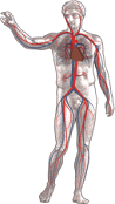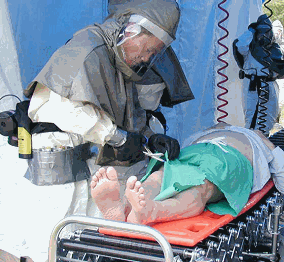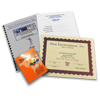4-Hour First Receiver Training
our E-Newsletter

Jump To Section
Regulation |
Open Enrollment Seminars |
Other Course Options |
Individual Products
Open Enrollment Seminars
This class is not scheduled for any upcoming seminars. It is available for On-Site
Training; call or E-mail us to schedule a seminar.
Optionally, you can purchase the On-Site Training Seminar Kit below.
Course Description
The First Receiver Awareness Level Program is designed to fulfill the requirements for first responders as laid out by OSHA under 29CFR 1910.120 (q)(6)(i) and adapted for hospitals in accordance with the publication OSHA's Best Practices for Hospital based First Receivers.
First Receiver Awareness level is required for a number of hospital personnel who would be responsible for notifying hospital authorities of the arrival, but would not reasonably be anticipated to have contact with the contaminated victims, their belongings, equipment, or waste. This list of personnel would including: Emergency Department Clinicians, Emergency Department Clerks, and Emergency Department Triage Staff. The group also includes decontamination system set-up crew members and patient tracking clerks, if their roles do not put them in contact with contaminated victims, their belongings, equipment, or waste.
First Responder Awareness Level training also is required for hospital security guards who work away from the Hospital Decontamination Zone, but who may be involved tangentially in a mass casualty event.
Our program allows you the flexibility of using pre-made lesson plans, PowerPoint, and student materials or the freedom of customizing the materials to fit your site specific training needs.
Course Regulation
29 CFR 1910.120:- (q)(6): Training. Training shall be based on the duties and function to be performed by each responder of an emergency response organization. The skill and knowledge levels required for all new responders, those hired after the effective date of this standard, shall be conveyed to them through training before they are permitted to take part in actual emergency operations on an incident. Employees who participate, or are expected to participate, in emergency response, shall be given training in accordance with the following paragraphs:
-
(q)(6)(i):
First responder awareness level. First responders at the awareness level are
individuals who are likely to witness or discover a hazardous substance release
and who have been trained to initiate an emergency response sequence by notifying
the proper authorities of the release. They would take no further action beyond
notifying the authorities of the release.
First responders at the awareness level shall have
sufficient training or have had sufficient experience to objectively demonstrate
competency in the following areas:
- An understanding of what hazardous substances are, and the risks associated with them in an incident;
- An understanding of the potential outcomes associated with an emergency created when hazardous substances are present;
- The ability to recognize the presence of hazardous substances in an emergency;
- The ability to identify the hazardous substances, if possible;
- An understanding of the role of the first responder awareness individual in the employer’s emergency response plan including site security and control and the U.S. Department of Transportation’s Emergency Response Guidebook;
- The ability to realize the need for additional resources, and to make appropriate notifications to the communication center.
- It is also a prerequisite to the 24-Hour Emergency Response Technician Program.
The Following Topics are Covered by this Course


- Regulation History
- OSHA Best Practices Regulation
- Hazardous Material Classes
- Segregation Charts
- Hazard Identification
- Signs And Symptoms
- Emergency Response Plan Sample
- Conclusion
- Course Review And Final Test
Other Course Options
Seminar Kits for Instructors
On-Site Training
New Environment, Inc. offers On-Site Training for this course, call or E-mail us to schedule this course.
Individual Products
Presently we do not offer individually packaged products for this course.


